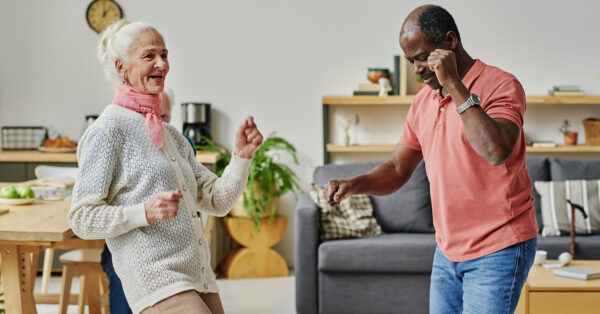Let’s Dance! For Health and Fun

“Dance is the hidden language of the soul.”—Martha Graham
Has a New Year’s resolution to add more physical activity into your daily routine come and gone? This is normal. We all start out strong and encouraged. Then life sometimes gets in the way.
This happened to me last year. I started to increase my walking frequency and distance. And then I had a major stumble crossing a street. I twisted my ankle in a pothole and, in breaking my fall, I ended up breaking my ankle and my wrist.
During my recovery, walking was off the table, though I continued to participate in an exercise class at my local senior center—from a chair!
The exercise program I participate in has dance as its foundation and each routine is accompanied by energizing music. I found that movement from a chair was as enjoyable and beneficial as exercising from a standing position during my healing.
I also continue to enjoy the social aspects of classes—I’ve met new people in my community. We laugh a lot during class, mostly at ourselves. We gather for conversation before and after. It’s celebratory, engaging, and I leave feeling better overall. The music is an added bonus.
Why dance?
Dance has been part of human history for millennia. All cultures and countries have special dances for celebrations and ceremonies.
Dance is a performing art. Participation in the arts contributes to “improving communication and expression” and “increasing physical, emotional, cognitive, and/or social functioning,” according to the National Coalition of Creative Art Therapies.
Dance of any style packs holistic health benefits. Evidence is well documented:
- Better cardiovascular and lung health as well as weight management
- Greater strength and endurance, including bone health
- Improved balance, spatial awareness, flexibility, and agility
- Stress reduction and management
- Enhanced cognition and mental functioning
- Opportunities for social connection
- Improved general and psychological wellbeing
Start slow
Do what feels comfortable. If balance is a concern, starting “dance” from a chair can be a great option—I can attest to that!
Moving shoulders, arms, hands, upper body, and head to the beat of favorite music can be a subtle, comfortable way to get in some exercise. Act like a symphony conductor. Pantomime along to the words of a song. Dress in costume and become a character. Enjoy the music!
Variety is the spice of dance
Here in King County, there is a wide, wonderful variety of dance programs, some specific to older adults. And it includes a range of cultural, ballroom, contemporary, and jazz approaches and styles. Tai Chi and Qigong are options to consider as well.
Now is a perfect excuse to learn something new. Have you always wanted to tap dance? Learn ballroom routines? Practice the basics of ballet? There are classes for that!
Belly dancing is offered at the Northshore Senior Center’s Kenmore location. The Senior Center of West Seattle has occasional swing dance and waltz opportunities, as well as line dancing—as does the Issaquah Senior and North Bellevue Community Centers. Tango stride is popular at the Southeast Seattle Senior Center. The ACRS Club Bamboo Senior Center has a rich variety of dance-based programs.
If you live with Parkinson’s disease (PD), check out Dance for PD, which offers in-person and at-home options. Here locally, the program is offered through Seattle Theatre Group (STG). Learn more by clicking here.
Check your local community and senior center, YMCA, cultural center, and the Seattle Parks & Recreation Lifelong Recreation catalog for dance classes or dance-inspired exercise programs.
With practice, we can all learn basic dance moves—maybe even learn a couple from younger family members and friends.
Dance is a mood and spirit lifter. And it’s something we can do anywhere, anytime, regardless of weather or location. What’s more, it doesn’t feel like exercise!
Ready to get started on your dancing journey?
Here are a few things that are recommended:
- Visit your health care provider before starting any exercise program.
- Wear appropriate, properly fit shoes.
- Warmups and stretches before any physical activity are a MUST.
- Stay hydrated and fuel your body with good nutrition.
- Listen to your body; go at your own pace.
- Don’t be intimidated—that’s what I love most about my dance class crew, we don’t take ourselves too seriously!
Dance as exercise brings me back to my childhood—square dance in school, polkas for all occasions (I grew up in the Midwest), my twice-weekly ballet lessons, and school and park dances. Those joyful, fun, youthful associations with rhythmic movement have returned, and it keeps me returning to dance.
 Contributor Keri Pollock directs marketing and communications for Aging Wisdom, a care management and creative engagement practice based in Seattle. She is a member of the Age Friendly Coalition for Seattle and King County and serves on the Phinney Neighborhood Association (PNA) Board.
Contributor Keri Pollock directs marketing and communications for Aging Wisdom, a care management and creative engagement practice based in Seattle. She is a member of the Age Friendly Coalition for Seattle and King County and serves on the Phinney Neighborhood Association (PNA) Board.
![AgeWise King County [logo]](https://www.agewisekingcounty.org/wp-content/themes/agewisekingcounty/images/logo.png)